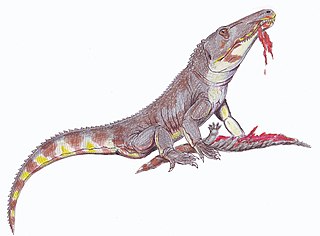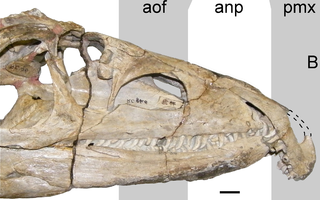
Archosauriformes is a clade of diapsid reptiles encompassing archosaurs and some of their close relatives. It was defined by Jacques Gauthier (1994) as the clade stemming from the last common ancestor of Proterosuchidae and Archosauria. Phil Senter (2005) defined it as the most exclusive clade containing Proterosuchus and Archosauria. Archosauriforms are a branch of archosauromorphs which originated in the Late Permian and persist to the present day as the two surviving archosaur groups: crocodilians and birds.

Ankistrodon is an extinct genus of archosauriform known from the Early Triassic Panchet Formation of India. First thought to be a theropod dinosaur, it was later determined to be a proterosuchid. The type species is A. indicus, described by prolific British zoologist Thomas Henry Huxley in 1865. One authority in the 1970s classified Ankistrodon as a senior synonym of Proterosuchus. Ezcurra (2023) found Ankistrodon to be a nomen dubium, as the teeth are indistinguishable from those of Proterosuchus. A second Indian proterosuchid from the same formation, Samsarasuchus, was also described in the same study, making it the only known valid proterosuchid from India.

Chasmatosuchus was an archosauriform reptile from the early Triassic period of European Russia. One of the earliest described archosauriforms, it was over 2 m long and is thought to have behaved like a modern crocodile. Its mouth had two distinct features: the top of its jaw hooked downwards to aid in holding prey, and the upper palate was lined with a row of teeth—a primitive feature lost in later archosaurs.

Proterosuchidae is an early family of basal archosauriforms whose fossils are known from the Late Permian and the Early Triassic. The highest diversity of genera is known from European Russia, but fossils are also known from South Africa, India, China, Australia, Brazil and possibly Argentina. The name comes from Greek πρότερο- ("first") and σοῦχος ("crocodile").

Garjainia is an extinct genus of erythrosuchid archosauriform reptile from the Olenekian of Russia and South Africa. It was approximately 1.5–2 metres (4.9–6.6 ft) long. It contained two species, Garjainia prima from the Yarengian/Yarkenskian Supergorizont of Russia, and Garjainia madiba from the Burgersdorp Formation of South Africa. "Vjuskovia triplicostata", a name assigned to some erythrosuchid fossils from Russia, has been synonymized with Garjainia prima.

Proterosuchus is an extinct genus of archosauriform reptiles that lived during the Early Triassic. It contains three valid species: the type species P. fergusi and the referred species P. alexanderi and P. goweri. All three species lived in what is now South Africa. The genus was named in 1903 by the South African paleontologist Robert Broom. The genus Chasmatosaurus is a junior synonym of Proterosuchus.

Tasmaniosaurus is an extinct genus of archosauromorph reptile known from the Knocklofty Formation of West Hobart, Tasmania, Australia. The type species is T. triassicus. This genus is notable not only due to being one of the most complete Australian Triassic reptiles known, but also due to being a very close relative of Archosauriformes. Once believed to be a proterosuchid, this taxon is now believed to have been intermediate between advanced non-archosauriform archosauromorphs such as Prolacerta, and basal archosauriforms such as Proterosuchus. Features traditionally used to define Archosauria and later Archosauriformes, such as the presence of an antorbital fenestra and serrated teeth, are now known to have evolved prior to those groups due to their presence in Tasmaniosaurus.

Kalisuchus was a genus of basal archosauriform known from remains unearthed from the Arcadia Formation of the Early Triassic of the Crater, Southwest of Rolleston, south central Queensland, Australia. It was named after Kali, the Hindu goddess of destruction, a reference to the very fragmentary nature of its remains. The type species of Kalisuchus is K. rewanensis, which refers to the Rewan Group. The Arcadia formation is dated to the Induan age at the very beginning of the Triassic, making Kalisuchus one of the oldest archosauromorphs known in Australia.
Indolyrocephalus is an extinct genus of prehistoric amphibian belonging to the family Trematosauridae. It contains a single species, I. huxleyi, from the Early Triassic Panchet Formation of India. It was initially classified in Gonioglyptus, then into its own genus Indolyrocephalus, and then back into Gonioglyptus, but is presently placed in Indolyrocephalus once again.
Pachygonia is an extinct genus of temnospondyl amphibian from the Early Triassic Panchet Formation of India. It contains a single species, P. incurvata. It may potentially be a member of the family Brachyopidae.
Jaikosuchus is an extinct genus of proterosuchid archosauriform. It contains a single species, J. magnus. Fossils have been found from European Russia that date back to the upper Olenekian stage of the Early Triassic.
Tsylmosuchus is an extinct genus of proterosuchid archosauriform reptile known from Western Russia. Fossils referred to Tsylmosuchus occurred over a wide area in sediments corresponding to the Induan and Olenekian stages of the Early Triassic. Most of these fossils are fragmentary neck vertebrae which were originally reported as sharing similarities with crocodile-line archosaurs (pseudosuchians) such as Mandasuchus. As a result, Tsylmosuchus was first described as part of the family Rauisuchidae, making it supposedly one of the oldest known archosaurs. However, its fragmentary remains do not show any of the distinguishing features of rauisuchids or even pseudosuchians in general, so Tsylmosuchus has more recently been interpreted as an indeterminate archosauriform. Although three species of Tsylmosuchus have been named, they lack diagnostic traits and are probably not distinct from each other. In 2023, Tsylmosuchus was reinterpreted as a proterosuchid, specifically a member of the subfamily Chasmatosuchinae.

Youngosuchus is an extinct genus of archosaur from the Middle Triassic of China. The type species is Y. sinensis. Y. sinensis was first described in 1973 as a new species of the erythrosuchid Vjushkovia. In 1985, it was reassigned as its own genus of rauisuchid. A 1992 study supported the original classification of Youngosuchus sinensis as an erythrosuchid, but more recent studies classify it as a "rauisuchian"-grade loricatan archosaur completely unrelated to Vjushkovia, which is most likely a synonym of Garjainia.
Vonhuenia is an extinct genus of proterosuchid, a basal archosauriform from the Early Triassic of Russia. Fossils have been found in the Vokhminskaya Formation, along the Vetluga River that are Induan in age, making Vonhuenia one of the earliest archosauriforms.
Blomosuchus is an extinct genus of archosauriform from the Early Triassic of Russia. The type species was named in 1992 as Blomia georgii. However, the name Blomia was preoccupied by a genus of mites in the family Glycyphagidae (Blomia), so the genus was renamed Blomosuchus in 1997. Fossils of Blomosuchus have been found along the Vetluga River besides fossils of another problematic archosauriform, Vonhuenia.
Exilisuchus is an extinct genus of archosauromorph reptile from the Early Triassic of Russia. The type species E. tubercularis was named in 1979. Fossils are known from two Russian assemblages, the Benthosuchus - Thoosuchus assemblage and the Angusaurus assemblage. Both are Olenekian in age. Although initially believed to be a proterosuchid archosauriform, a 2016 analysis found that it also shared features with tanystropheids, and thus is currently classified as Archosauromorpha incertae sedis. Due to the small amount of preserved material, this genus is sometimes considered a nomen dubium.
Gamosaurus is an extinct genus of proterosuchid archosauriform. It contains a single species, Gamosaurus lozovskii, named by Vitalii Georgievich Ochev in 1979.

Eorasaurus is an extinct genus of archosauromorph reptile known from the middle Late Permian of Tatarstan, European Russia. It contains a single species, Eorasaurus olsoni. When originally described by Sennikov (1997), Eorasaurus was identified as an early archosauromorph and assigned to the family Protorosauridae, Ezcurra et al. (2014) and Ezcurra (2016) later reclassified Eorasaurus and placed it within the group Archosauriformes. Eorasaurus is based solely on scant fossil material from the neck region, and is thus considered an unstable taxon in phylogenetic analyses. If Eorasaurus is an archosauriform, it would be the oldest known member of the group and would pre-date the previous record holder.
The Panchet Formation is an Early Triassic geological formation from the Damodar Valley of India.
Samsarasuchus is an extinct genus of archosauriform reptile from the Early Triassic of India. This genus has one known species, Samsarasuchus pamelae. Samsarasuchus lived a few million years after the Permian-Triassic extinction, the largest known mass extinction event. It was a member of the Proterosuchidae, a group of successful crocodile-like reptiles that survived the extinction event and were among the earliest successful archosauromorphs.
















